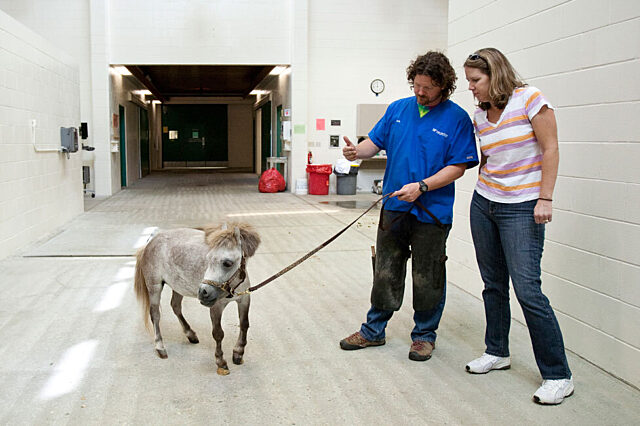Monthly treatments at UF keep tiny horse on its feet

Jody Schaible, UF’s Large Animal Hospital’s farrier, talks to Debbie DeHowitt, Buttercup’s owner, in the Large Animal Hospital recently. (Photo by Maria Farias/University of Florida)
Big things really do come in small packages, if you ask Debbie DeHowitt, whose horse-loving heart belongs to the “mini-minis.”
DeHowitt’s 4-year-old mini-miniature horse, Buttercup, has been a client of the UF Large Animal Hospital from an early age, when it became clear that she needed special care for hoof problems.
“When she was 6 or 7 months old, I became aware that she was starting to walk on the outside of her front hooves,” DeHowitt said. Her veterinarian had a farrier — someone whose job is to make horseshoes and fix there hooves — create extensions to widen Buttercup’s hooves to fix the problem.
At first, the extensions seemed to work, but eventually Buttercup’s condition worsened. DeHowitt made a five-hour trip to UF from her home in Hollywood, Fla., to explore possibilities for further treatment. Surgery was ruled out so Buttercup began what would become a part of her health maintenance routine – visiting UF’s farrier, Jody Schaible, every month for the next three years for corrective hoof care.
“Jody has been great to us,” DeHowitt said. “Over the years, he has had to switch from pre-made shoes to different materials to extend her hooves and keep her comfortable. Without Jody, I know that Buttercup would not be turning 4 later this month.”
Schaible said working on Buttercup had been a challenge from the start.
“I have to take into consideration that her feet are extremely small. If you held a quarter on the bottom of her foot, the quarter would cover 95 percent of her foot, so nailing shoes is out of the question.”
Buttercup needs special glue-on shoes that only attach to the outside of her foot to provide support to her leg, Schaible said.
“The other problem is that she cannot stand on one leg to glue on the shoes, so we are forced to sedate her and lay her on her side, then work on one foot, flip her over and repeat the process again on the other foot,” he said. “It’s a labor of love and Buttercup has become a very important part of the UF family.”
Buttercup belongs to a category of miniature horses known as dwarfs, whose tiny size creates known health concerns, including crippling leg deformities. DeHowitt had initially purchased Buttercup’s mother, Annabel, from a breeder who wasn’t happy with the animal due to her propensity for birthing mini-miniature horses, also known as dwarfs.
“Within a few weeks, I also bought her dwarf son, because he was being picked on by all the other animals on the farm once his mother was not there to protect him,” DeHowitt said. Soon, Annabel began gaining weight, and DeHowitt learned her new horse was again pregnant.
Buttercup was born prematurely and weighed only 20 pounds.
“She couldn’t figure out how to nurse and had to be force fed for the first 24 hours,” DeHowitt said. “But as the days progressed, it quickly became apparent that Buttercup was a fighter. She was so tiny, but she had such spirit and thought she was just as big as everyone else.”
DeHowitt said she knew nothing about dwarf miniature horses before living with Buttercup, but now appreciates why the health issues faced by these horses can be so challenging.
“There is a real need for a dwarf rescue group because of the costs that are involved with having them,” DeHowitt said. “My dream is to one day start a rescue group specifically for dwarfs.”
About the author
